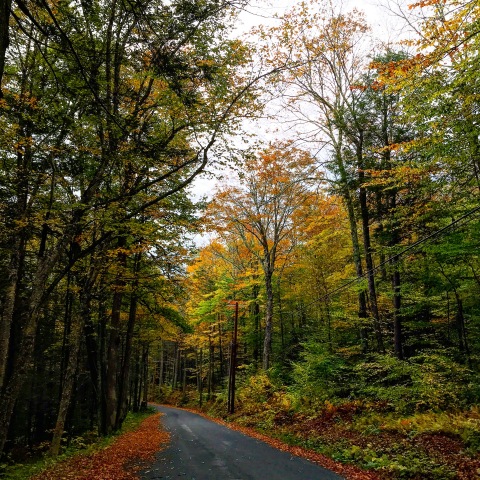A few weeks ago, I posted this picture on Instagram. Immediately, my more smart-arsed friends began to chatter. I used the hashtag #nofilter, meaning that I did not use an Instagram filter. Not good enough for the commentariat, though. They commented on the mental filters, frame filters, and so on as I framed the photo and so on. They’re not wrong. (The photo, if you are wondering, is of a creek about a mile from my home in Western Massachusetts).

Of course this photo was filtered, from the way the creek caught my eye as I walked the dogs, to the way I framed the photo as I took it, choosing what to get into the photo and what to leave out. All photos are filtered and framed. Duh. I’ve been mulling over this since.
Then I saw the obligatory article in the Washington Post about where to go to see fall foliage colours. The first photograph in the article is from another locale in New England, Albany, NH. It’s a stunning photo of rushing water and brilliant reds. Meanwhile, my friend Matthew Friedman has been running around New York and New Jersey with a real camera of late, taking some absolutely stunning photos that he develops himself, as he is a man of many skills. Taken together with my apparent addiction to Instagram, a lightbulb went off in my head when I posted this picture in my feed:

This is a heavily filtered and edited photo showing the brilliant autumn colours on my street. But notice how the oranges and yellows and greens, and the auburn of the dead leaves, pop in this photo. Not unlike the reds of the leaves and the white of the rushing waters in the photo from Albany, NH, in the Post article.
The differences between the heavily edited and filtered photo I posted and the original are striking, I think.

This is still a beautiful shot, I think. But the colours aren’t as gripping, they don’t pop. And the lighting is much darker than in my Instagram post. So what did the original of the Albany, NH, photo in The Post look like? I presume Jim Cole, the AP photographer, shot it with a digital camera and ended up with an original that looks like mine. But then he edited it with editing software until the reds and yellows of the leaves and the white of the rushing water and the blacks of the stones in the river popped like that. The photo is glossy. And it’s beautiful. It’s an arresting image, and it is no surprise it is the lead photo in the article.
Photography as we think about it is filtered and edited, oftentimes heavily. It is often also staged. Or consider the fact that Robert Doisneau’s famous photos of lovers kissing outside Hôtel de Ville in Paris was staged. This is one of the most iconic photos of all-time, and has been used for any range of purposes, almost all of which have to deal with the romanticization of Paris. But these were not two lovers. They were two models Doisneau hired for the day. Does that lessen the impact of the photo? No. It doesn’t. In fact, Doinseau was unapologetic, noting that he did not photograph life as it is, but as we wish it to be.

So, yes. Almost ALL photos are filtered, beyond the mental filters and the framing of the photo. They are filtered via the production process, whether in a darkroom as Doisneau and Friedman work, or digitally, as Cole and I have done.
Kind of obvious, no?
